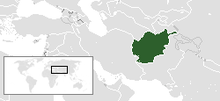1973 Afghan coup d'état
| 1973 Afghan coup d'état | |||||||
|---|---|---|---|---|---|---|---|
 | |||||||
| |||||||
| Casualties and losses | |||||||
| 8 officers | |||||||
The 1973 Afghan coup d'etat took place on July 17, 1973 in Kabul, Afghanistan when forces led by then-army commander Lieutenant General Mohammed Daoud Khan and then-Chief of Staff General Abdul Karim Mustaghni overthrew the monarchy in a somewhat bloodless coup. At the time King Mohammed Zahir Shah was abroad receiving eye surgery and treatment for low back pain in Ischia, Italy. Daoud Khan was assisted by leftist Afghan Army officers and civil servants from the Parcham faction of the PDPA, including Afghan Air Force colonel Abdul Qadir. Eight officers were killed. King Zahir Shah decided not to retaliate and he formally abdicated on August 24, remaining in Italy in exile. More than two centuries of royal rule (since the founding of the Durrani Empire in 1747) ended.[1]
Background
The King had ruled since 1933, and his cousin Mohammed Daoud Khan had served as Afghan Prime Minister from 1953 to 1963. Daoud Khan had strained relations with the King[2] and he was also unable to hold political office after the 1964 constitution, which barred members of the royal family.[3] Some believe the King did this on purpose because of Daoud Khan's strong pro-Pashtunistan views, which he deemed too radical. Daoud Khan took the opportunity during growing discontent from the public over promotions in the armed forces and the King's poor response to the famine in 1971-72 that is believed to have killed thousands in the central and north-western parts of the country.
Aftermath
Despite being part of the royal family, Daoud Khan abolished the kingdom and created a new presidential Republic instead, declaring himself as president, foreign minister and head of the army. The royal Arg (palace) in Kabul became the official Presidential residence.[4] He called the coup a "national and progressive revolution". A new constitution was made in 1977 which turned the country into a one-party state. During his time as head of state, Daoud Khan's relations with the Soviet Union, Pakistan, and the communists, deteriorated. Eventually he was overthrown and killed during the Saur Revolution in 1978.
See also
References
- ↑ "Afghanistan - Daoud's Republic, July 1973 - April 1978". countrystudies.us. Retrieved 2018-03-12.
- ↑ Edwards, David (2 April 2002). Before Taliban: Genealogies of the Afghan Jihad. University of California Press. ISBN 978-0520228610.
- ↑ Dil, Shaheen F (June 1977). "The Cabal in Kabul: Great-Power Interaction in Afghanistan". American Political Science Review. 71 (2): 468–476. doi:10.1017/S0003055400267397.
- ↑ Barfield, Thomas (March 25, 2012). Afghanistan: A Cultural and Political History (Princeton Studies in Muslim Politics). Princeton University Press. ISBN 978-0691154411.